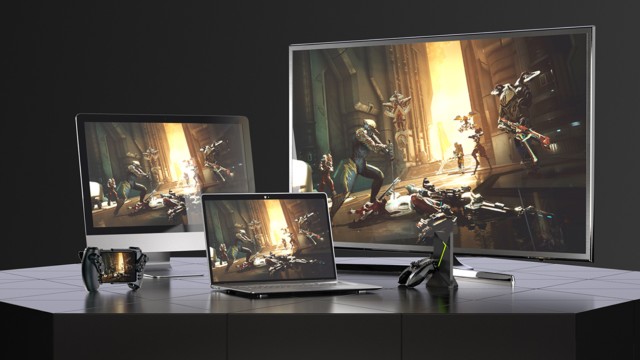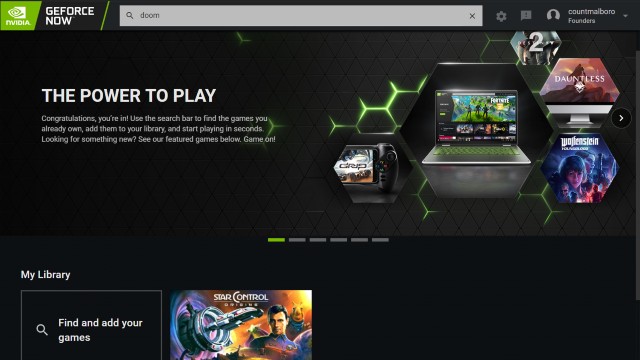Nvidia’s GeForce Now service is out of beta and available for everyone, but is it worth it? So far, game streaming hasn’t been too impressive. Google Stadia recently released to a lukewarm response, and PlayStation Now sometimes seems like it’s an afterthought to Sony (though it works really well and has a great library). Is game streaming even worth fooling with at this point?
We’ll dive into what separates GeForce Now from its most immediate competitor, Google Stadia. We’ll also take a look at some of the weaknesses of the service, and whether it’s ready for full release or not.
ALSO: Tom Nook Is Not Evil! A defense of Animal Crossing’s bad businessman
How does GeForce Now work?
Whether or not GeForce Now is worth it depends on multiple factors. For one, unlike with Stadia, you don’t buy the games from Nvidia. Instead, you pay a small fee each month to stream games you already own on Steam, uPlay, Epic Games Store, Origin, Bethesda Launcher, or Battle.net via Nvidia’s servers.
This means your existing library of games is a significant factor in whether or not GeForce Now is worth it to you. The more games you already have on PC, the more value you’ll get out of the service.
Of course, if you already have a lot of PC games, you likely already have a gaming rig that can outshine what GeForce Now offers. The service is limited to 1080p, though you can crank games up to ultra. I noticed games seemed to load a bit slower than they do on a regular SSD as well. Latency, fortunately, isn’t too much of an issue, but I did notice some stuttering now and again.
The biggest advantage of GeForce Now is that you can take your PC gaming library on the go. But, like Stadia, this is also its greatest weakness. The places GeForce Now would be the most useful, airports, hotels, buses, and the like, don’t typically provide the roughly 15GB/hr bandwidth the service needs to run. So, you can use the service on PCs, Macs, Android devices, and Nvidia Shield products. But, you’ll likely only use the service regularly if you’re at home but don’t want to play on your gaming PC. Even then, the free Nvidia GameStream feature or Steam Link works better.
Nvidia GeForce Now vs. Google Stadia | Which is better?
I’ve seen GeForce Now compared to Google Stadia, and the two services really aren’t much alike other than the fact they stream games. The most significant difference is that GeForce Now streams games you already own. In contrast, you have to buy Stadia games directly from Google.
GeForce Now wins as far as its business model goes, but Stadia is better in almost every other way. For one, the GeForce Now interface needs a lot of work. With Stadia, you load the webpage or app, and you’re one or two button presses away from playing any of your games. With GeForce Now, it’s considerably more complicated.
GeForce Now supports quite a few storefronts, but it doesn’t support all the games on those storefronts. However, instead of letting you log into Steam, for example, and then returning a list of the games you can play, you have to check every game individually via the search function to see if it’s supported.
If you’ve got a massive library of games on Steam, it’s incredibly tedious to see what you can play on GeForce Now. The service is also missing a lot of titles. So, you can play Doom (2016), but not Resident Evil 2 remake.
Fortunately, there’s a 90-day no-risk trial available now so you can check all your games and make sure they’re available on the service before you commit to playing the $5 a month for it. There’s also a free tier that lets you play games in one-hour sessions which enables you to get a quick demo of GeForce Now without even putting in your payment details.
Is GeForce Now worth it?
Again, GeForce Now and services like it won’t reach their full potential until high-speed, low-latency internet is available on a much larger scale than it is now. Streaming PC games to your phone or laptop seems like a cool idea until you’re sitting in a hotel with internet that chugs trying to load YouTube, and you realize that there’s no way it’s going to work.
However, with GeForce Now, you can demo the service easily and see if it’s something that appeals to you. I think the use cases for game streaming are pretty limited right now, but this is probably the perfect thing for some people. I’d say it’s more worth it than Stadia, but even then, it’s a relatively niche product.









